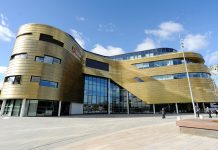A report by AUDE shows how universities are making efficiency gains, while working to deliver increased value from their estates for the benefit of student and staff plus the wider community. Rosie Niven sums up some of the strategies universities are using to deliver these efficiencies.
Research by AUDE, which fed into Universities UK’s recent report on efficiency, effectiveness and value for money in higher education, estimates that universities have saved £7.2bn over the ten years to 2012-13 through more efficient use of space.
A report containing the research included case studies that highlighted what universities are doing to get more value for money from their estates. Here are six examples of strategies that universities in the case studies are using.
1. Enabling year-round use of facilities
Coventry University opened its Engineering and Computing Building (ECB) in 2012. The ECB was designed to encourage the study of STEM subjects and support the faculty’s research, commercialisation and outreach work.
The building is well used not only during the core semester weeks, but throughout the year. Because the university has student intakes in January as well as September, teaching takes place year round.

The building is also in demand across the university for hosting conferences and other activities. In the first year of operation, to enhance student experience, a pilot project was carried out to extend the opening times of the building, keeping it open 24/7 for a six week period before exams.
The success of the pilot has led to the building now regularly operating extended opening hours at weekends between January and June each year and for a six week period prior to final coursework and project submissions and exams operating on a 24/7 basis.
2. Making facilities accessible to businesses
Building partnerships with businesses can be one way universities can ensure that their research facilities are better used. It can also help the development of spin-out companies, which can bring in income, boost an institution’s REF credentials, enhance graduate employability prospects and strengthen relationships with business.
At Imperial College, the new campus being developed at White City will include facilities for translating research into direct applications and spinout companies.
The campus will co-locate world class researchers, businesses and higher education partners to create value on a local, national and global scale. This collaboration will both generate new businesses and enable existing small businesses to scale more rapidly. This approach will make a contribution to national economic growth and the creation of jobs.
In the longer term, the site will also provide conference, residential and leisure facilities in an area where regeneration has been a longstanding objective.
While Imperial has produced more spin-out businesses than any other UK university – 140 over the last ten years – the institution has been able to accommodate only 10-15 at any one time within the limited space available in its South Kensington Campus Incubator. The new Research and Translation Hub will provide facilities for many more spin-outs and support the growth demands of start-ups from inception through to maturity.
3. Sensitive remodelling of historic buildings for modern uses
Modern buildings offer many advantages, from energy efficiency to the provision of flexible space which allows multiple uses. However, many universities find that their historic buildings present more challenges when it comes to realising efficiencies.
Loughborough University has found a solution to this particular problem. Its Hazlerigg building was the oldest on campus and a cornerstone of the surrounding conservation area. It was constructed in 1937 as a hall of residence, but it could no longer meet the requirements of modern student residential accommodation.
The university implemented a £25m master plan for the Central Park area of the campus, which resulted in the co-location of academic departments in single buildings or adjacent buildings both to support academic aims and improve the student experience.

The reconfiguration of the space also enabled a more integrated administrative focal point for the university, more sharing of facilities such as printing, and contributed to meeting carbon reduction targets.
4. Striking the right balance between specialist facilities and flexible space
In general, older buildings are less capable of being adapted to meet changing needs, according to AUDE’s research. Recognising this, many universities are addressing this issue in their estates redevelopment plans.
The University of Strathclyde’s Technology and Innovation Centre is under development in Glasgow City Centre and will provide flexible laboratory facilities for multidisciplinary research teams with strengths in engineering, science, business, the humanities and social science.
The building will house up to 700 researchers, academics and industry partners in an environment designed to nurture academic and industrial cross-fertilisation and open up new research and commercialisation opportunities.
More than 100 specialist lab and workshop spaces will sit alongside research workspace accommodation, fostering the knowledge exchange and social interaction that will be at the heart of the development. Long term flexibility and the ability to reconfigure space are two important elements of the building’s design.
As well as research space, the building will also provide conferencing and event facilities, a café and exhibition space including a 450 seat auditorium which can be divided into three self-contained areas seating 150.
5. Achieving space efficiencies through campus rationalisation
Over the past ten years, Manchester Metropolitan University has implemented a major rationalisation and renewal strategy for its estate, which has improved the delivery of academic teaching and research activity. During this period, the university’s estate has been transformed with the number of campuses reduced from seven to two. The result has been a high quality, consolidated and sustainable estate based in central Manchester and Crewe, Cheshire.
Financed entirely from MMU’s existing resources, the delivery of the estate strategy represents one of the largest and most ambitious investment programmes of any UK university.
The initial plan for estate consolidation took shape in 2004. At that time, the university was dispersed across five campuses in central and south Manchester. There were also two campuses at Crewe and Alsager nearly 40 miles away from central Manchester.
Key drivers of the consolidation were firstly a desire to achieve economies of scale by having two campuses to focus on teaching, research, services and support, and secondly removing duplication of services and improving overall efficiency in the size of the estate.
The project has delivered a range of benefits including efficiency gains, environmental sustainability, improved building quality, as well as enhancing student experience and community engagement.
6. Promoting use of shared space
The University of Sunderland has implemented a strategy of consolidation on two campuses. By reducing duplication and providing fit-for-purpose facilities, the university has been able to reduce the size of its estate by over 15%. Over £7m was invested in the development to upgrade and reconfigure more than 4,000 square metres within the complex, which has now been in use for three years.
The concept of shared spaces was a key element of the project. All specialised analytical equipment that was previously widely dispersed was consolidated into one laboratory. This freed up space for more general teaching activity and created a first class analytical suite for teaching, research and commercial purposes.
Many different subject areas could make use of the general purpose laboratories. To enable technical staff to store the equipment and consumables needed for different subjects, the new prep labs needed to be significantly larger than their predecessors. This strategy enabled the university to reduce expensive laboratory infrastructure, cut running costs and reduce space requirements from four buildings to one.
One of the objectives of the project was to rationalise under-used accommodation. A good example of this was the Faculty of Applied Sciences which was able vacate a poor quality pre-fabricated building of 660 square metres which the university plans to dispose of in the longer term.
With the new configuration of office space, the ratio of space per staff FTE reduced from 11.5 to 7.6 square metres. The total area of laboratory space changed from 5,536 square metres to 4,195 square metres, and utilisation has increased from 10% to nearly 30%.
The research was carried out by Kilner Planning and London Economics for AUDE and its partners, Universities UK, the Higher Education Funding Council for England and the British Universities Finance Directors Group. The report is available to download on the AUDE website.








